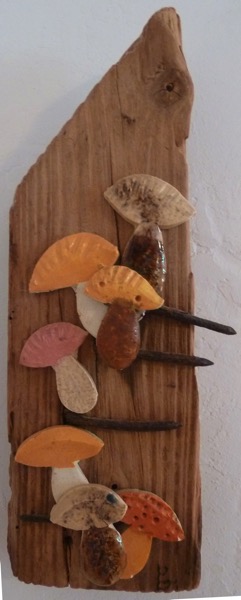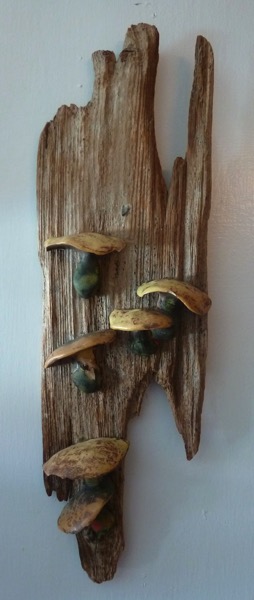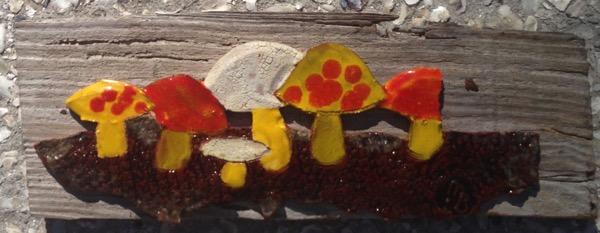A World of Mushrooms
I did not know that Mary had a form of synesthesia, known as chromesthesia in the academic world, until after she had passed away. This fact explains her fascination with music and color – she loved classical music and played the piano, though not well. She had learned to play the piano at home, apparently, though she never spoke about it, and she attended two summer sessions at the Julliard School of Music in New York City in the early 1930s. The fact that she saw colors when she heard music goes a long way towards explaining her fascination with colorful life forms such as mushrooms, tropical fish, parrots, toucans and flowers. In the 1960s and into the 1970s, Mary created a number of mushroom plaques, a few of which I have located and will feature in this post.
This piece is in the collection of a ceramic artist in the Homestead area.

The glazes are pastels and the piece has a whimsie sticker on the back, indicating that it is an early piece. What I find most interesting about the piece is how Mary incorporated a piece of driftwood with rusted nails into her composition. Her work had a distinct wabi-sabi feel to it, though I doubt very much that the phrase was in use in this country in the 1960s. Mary had a number of books on Japanese temples and crafts and was no doubt inspired by the photographs in them.
This beautiful piece is also in the collection of a resident in the Homestead area:

Mary created mushrooms and then cut them in half, placing the halves on the wood to create a composition of color, shape, and contrast. This piece is not signed, but it is by Mary’s hand. It may have had a whimsie sticker on the back at one time but due to the wood that the mushrooms are mounted on, it probably came off.
This exquisite piece is another example of Mary’s careful attention to shape and composition.

I’m not sure what glaze was used for the stems of the mushrooms, but the tops are glazed with a glaze that was called cream matte.
The final piece featured in this post was created a little bit later than the previous pieces, I think. The wood is not of the quality of the earlier pieces (it became increasingly difficult to find such wonderful pieces of wood!) and the glazes are brighter, which means, to me, that the piece was probably created in the mid-1970s. It has some similarities with the first piece shown in this post, in that the mushrooms are flat, but in this piece, all of the mushrooms are part of the same piece of clay. The “ground” is textured and there is an “mb” stamp in the clay. The “mb” stamp didn’t come into wide use until perhaps 1973 or so.

This piece lives in Georgia, where it is cherished by the owner.

We used to go to Homestead to the house with our two sons to purchase clay art on wood to put around our pool which was circular. My favorite was a 6 ft or so big slab of wood with clay sunflowers . Over the years we made purchases from the Blakley.We also had small plaques with astoundingly colorful mushrooms.
They were so welcoming and friendly we all loved to visit with them.
My son Patrick (56 ) had an urge to see what happened to them and found your tribute to two talented parents!